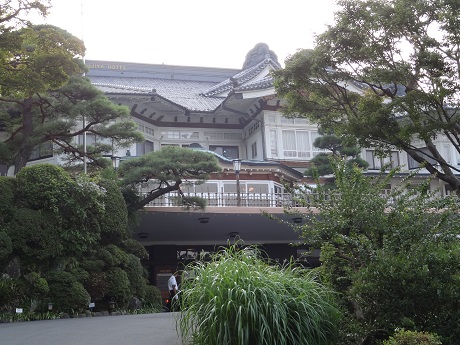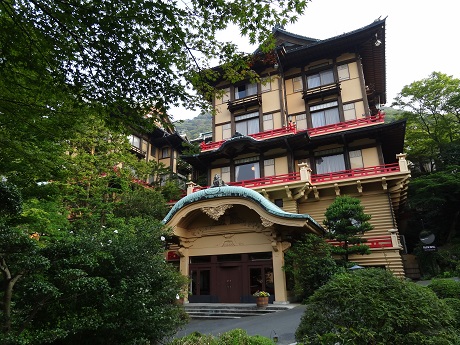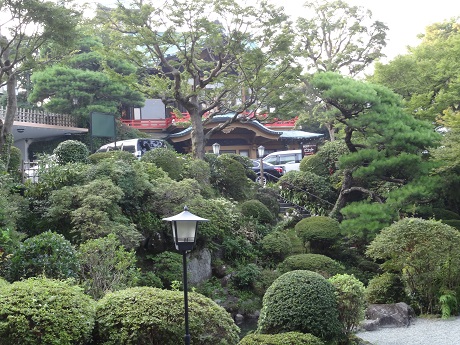Posts Tagged ‘tozan railway’
-
The Fujiya Hotel Part 1
0August 9, 2013 by IPAlchemist
How shall I write the praises of the Fujiya Hotel? I was completely captivated by it the first time I came across it, a few years ago when my friend Keizo was showing me around Hakone.
You need I think to consider a little the history. The founder Sennosuke Yamaguchi travelled to the USA and Europe and learned something of the Western hotelier tradition in the early Meiji period, and founded his hotel in 1878. It was apparently the first western-style hotel in Japan (if this is not strictly true it must have been one of the first), in the resort area of Hakone, popular even then. The original building burned down in the Miyanoshita fire in 1883, so the current main building dates from 1891. War, earthquake and fire means that even in a country so historic as Japan, Meiji period buildings are something of a rarity, so it is for me an enormous joy to be staying in an original Meiji building.
When we say “Western-style” we mean “Japanese interpretation of Western style” – it does not look anything like anything one might find in the actual West. The original building and most of the later additions are actually very Japanese in character, although with clear western influences. The result for me seems like a Japanese re-interpretation of a Swiss chalet.
Buildings were added in the late Meiji and Taisho periods (early 20th century), the former just after Japan’s success in the Russo-Japanese war, but I am most drawn by the two phases of later additions – one in the early Showa period, when Japan was expanding its empire in east Asia, and the second in the 1960s, when Japan was rebuilding itself. Through all these turbulent times, the Fujiya was trying to bring rest and relaxation to those in need. There is a museum in the basement chronicling some of the history, including a visit from the Showa Emperor himself in the 1960s. What it must have been like to be visited by a being sometime considered to be divine.
Although setting out to be a Western style hotel, the Fujiya is in fact based around that most Japanese of leisure attractions – the onsen or hot spring. That is what Hakone is famous for, and that is what you get at the Fujiya. There is a small public bath (separated by gender), a large onsen swimming pool that is mixed, and for which bathing costumes are required, but then the crowning glory is onsen water piped into the bath in your own room’s bathroom, through what appears to be genuine Meiji era plumbing. Guests are advised that the hot water can take up to 10 minutes to arrive. I think it actually takes longer.
The buildings are caked in layers of paint; modern additions such as electricity, air conditioning and internet are delivered in conduits attached to the original structure; and yet… And yet… The historic charm of years of people staying and relaxing here oozes enticingly out of every beam, windowframe, and wooden floortile.
The service, while certainly better than anything in hotels in London, does not quite achieve the effortlessly inconspicuous ideal of the Okura, but you have to pity staff who must deal, displaying Japanese politeness, with not only huge parties of staying guests, but also streams of tourists who come, alone or in groups, like Keizo and I did those years ago, just to ogle and perhaps have tea.
The building itself is very hard to photograph, set as it is upon a hill, and obscured from most directions by trees, but I will have a go.
The Main Building 1891
The Flower Palace 1936
The Restaurant – added 1930
The feeling of having got away from it all is greatly increased by choosing the correct way to arrive. Short it is not – it took a full four hours from Narita airport. The route is this: limousine bus to Shinjuku Station bus station; Odakyu railway Romance Car to Hakone Yumoto, and then Tozan railway three stops to Miyanoshita. It is this last bit that makes it all worthwhile – the train ascends nearly 500m in altitude in a series of 3 switchbacks, at each one of which the two drivers swap ends, climbing though thick vegetation, featuring densely packed hydrangeas. It was glorious. Then you just have to heft your luggage downhill then uphill for about 500m and then you are there.
A rather less welcome reminder of having got away from it all is the discovery that the nearby ATM does not accept foreign issued credit cards, followed by being politely informed by the hotel staff that they do not advance cash on cards, that there is no suitable ATM nearby, and that the nearest one that can be used is at Miyanoshita Post Office, not walkable, requiring a train, bus or taxi journey. Oh and the machine only functions until 6pm.
The odd thing is that despite the remote feeling, it is actually not remote at all by any objective standard. It is on the route of the old Tokaido road – the main route from Tokyo to Kyoto, and the current Japanese Route 1. So it is actually about as well connected as it is possible to be and still be apparently in the middle of nowhere. The road, despite its impressive moniker, is at this stretch only single carriageway and very twisty.
The main business of the day, however, was to have another tea like the one that had first enchanted me so much. So that is the subject of my next post.
Category Leisure, Travel | Tags: Fujiya Hotel, Hakone, Japan, Miyanoshita, tozan railway



